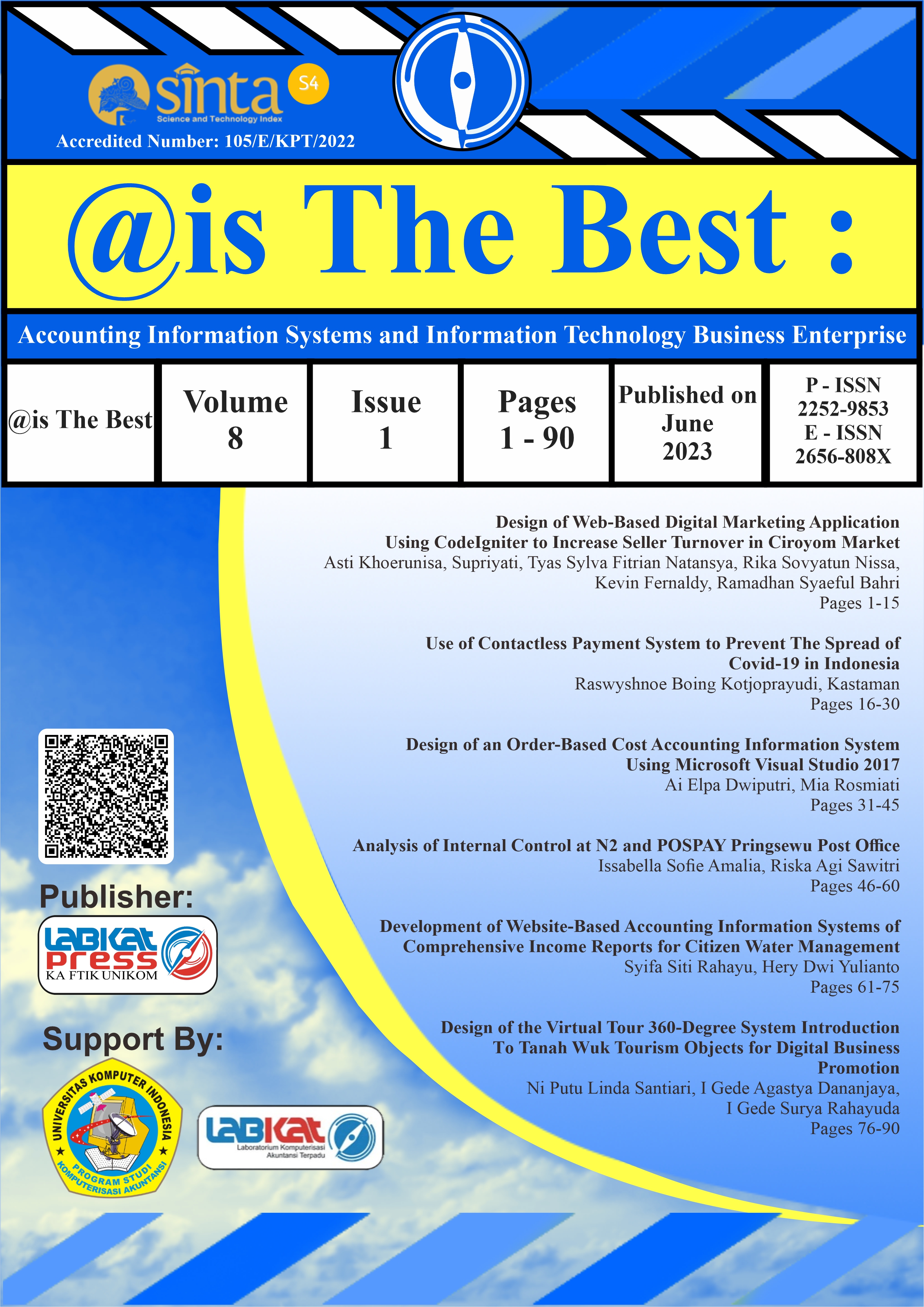Development of Website-Based Accounting Information Systems of Comprehensive Income Reports for Citizen Water Management
Main Article Content
Abstract
The current management of community water businesses still uses a manual or conventional system. The conventional system that occurs is that the officer manually records the use of water made in a recap, and then the financial section has no accounting information system, so it still uses Google Spreadsheets and accounting processes that refer to the accounting standards designed. Based on existing problems, a website-based accounting information system for comprehensive income reports for citizen water management is needed. The research objective is to build a website-based Citizen Water Management Comprehensive Income Report Accounting Information System. The research method used was descriptive survey research, in which the author describes a situation or phenomenon systematically in a clear and detailed manner, including processes and components that occur, to find solutions to the problems found. The population in the study is the financial details of the water fund in 2022, and the sample is the financial details of the water report for October 2020. The types of data collection methods are interviews, observation, and library research. In research, the type of design used is descriptive analysis with primary data. One of the system methods is the waterfall method. The result of his research was the design of a comprehensive income reporting accounting information system for web-based community water management so that it facilitates the process of recording transactions and producing accurate financial reports for citizen water management.
Downloads
Article Details
Section

This Journal is licensed under a Creative Commons Attribution-ShareAlike 4.0 International License
How to Cite
References
S. Supriyati dan R. S. Bahri, “Model Perancangan Sistem Informasi Akuntansi Laporan Keuangan Pondok Pesantren Berbasis SAK ETAP,” is The Best Accounting Information Systems and Information Technology Business Enterprise this is a link for OJS us, vol. 4, no. 2, hal. 151–165, 2020, doi: 10.34010/aisthebest.v4i02.2749.
Supriyati, H. Suharman, dan T. Supriadi, “Business strategy and use of information technology toward ASEAN MSMEs performance in the post-pandemic crisis,” Journal of Eastern European and Central Asian Research (JEECAR), vol. 10, no. 5, hal. 886–897, Sep 2023, doi: 10.15549/jeecar.v10i5.1438.
H. D. Yulianto dan D. F. Maulana, “Perancangan Sistem Informasi Akuntansi Persediaan Barang Dagang Menggunakan SAK EMKM Berbasis Web,” is The Best Accounting Information Systems and Information Technology Business Enterprise this is link for OJS us, vol. 5, no. 2, hal. 121–135, 2020, doi: 10.34010/aisthebest.v5i2.3244.
S. Supriyati, S. Mulyani, H. Suharman, dan T. Supriadi, “The Influence of Business Models, Information Technology on the Quality of Accounting Information Systems Digitizing MSMEs Post-COVID-19,” Jurnal Sistem Informasi, vol. 18, no. 2, hal. 36–49, 2022, doi: 10.21609/jsi.v18i2.1141.
Sahala Purba, Andro Siregar, dan Melva Esnida Saragih, “Penyajian Laporan Keuangan Entitas Berorientasi Non Laba Berdasarkan ISAK 35 Pada Gereja HKBP Km 55,” Kompak :Jurnal Ilmiah Komputerisasi Akuntansi, vol. 14, no. 2, hal. 308–339, 2022, doi: 10.51903/kompak.v14i2.586.
Y. Oktavia, “Penyusunan Laporan keuangan berdasarkan ISAK 35 Pada Kelompok Tani Mekar Sari,” Jurnal Akuntansi Syariah (JAkSya), vol. 1, no. 2, hal. 157, 2021, doi: 10.31958/jaksya.v1i2.4510.
G. F. W. Anugrah, I. N. P. Yasa, dan E. Sujana, “ANALISIS PERBEDAAN DASAR PERHITUNGAN TARIF HARGA AIR UTAMA (Studi Pada BUMDes Bhuana Utama Desa Panji , Kecamatan,” Jurnal Ilmiah Akuntansi dan Humanika, vol. 9, no. 3, hal. 263–272, 2019.
D. Felia Putri dan N. Nurlaila, “Analisis Sistem Pencatatan Manual Laporan Keuangan Terhadap Kinerja Akuntan Di Perusahaan Umum Daerah Pasar Kota Medan,” SIBATIK JOURNAL: Jurnal Ilmiah Bidang Sosial, Ekonomi, Budaya, Teknologi, dan Pendidikan, vol. 1, no. 6, hal. 763–770, 2022, doi: 10.54443/sibatik.v1i6.90.
T. Pricillia, “Perbandingan Metode Waterfall, Prototype,RAD,” Perbandingan Metode Pengembangan Perangkat Lunak(Waterfall, Prototype, RAD), vol. X, no. 01, hal. 6–12, 2021.
G. Nurcahya, H. Dhika, dan I. D. Lestari, “Perancangan Sistem Informasi Pembelajaran Ekstrakulikuler Kepramukaan Pada SMK Fatahillah Cileungsi Berbasis Android,” Jurnal Nasional Komputasi dan Teknologi Informasi (JNKTI), vol. 5, no. 5, hal. 826–833, 2022, doi: 10.32672/jnkti.v5i5.5012.
I. S. Maulana dan M. Rahmat, “Penerapan Isak No. 35 Tentang Penyajian Laporan Keuangan Entitas Berorientasi Nonlaba Pada Masjid Besar Al-Atqiyah Kecamatan Moyo Utara Kabupaten Sumbawa.,” JAFA Fakultas Ekonomi dan Bisnis UTS Journal of Accounting, Finance and Auditing, vol. 3, no. 2, hal. 63–75, 2021.
J. M. Hasan, L. D. Septiningrum, A. F. Chaery, T. A. Abdurachman, dan A. L. Prawirayudha, “Sistem Informasi Akuntansi (Flowchart) Dalam Pembangunan Masjid Al-Aulia,” Dedikasi Pkm, vol. 2, no. 1, hal. 118, 2020, doi: 10.32493/dedikasipkm.v2i1.8503.
F. Soulfitri, “Perancangan Data Flow Diagram Untuk Sistem Informasi Sekolah (Studi Kasus Pada Smp Plus Terpadu),” Ready Star, vol. 2, no. 1, hal. 240–246, 2019.
H. D. Yulianto dan R. Fauzi, “Design of Web-based Online Sales Information System,” IOP Conference Series: Materials Science and Engineering, vol. 879, no. 1, 2020, doi: 10.1088/1757-899X/879/1/012007.
D. Alfiansyah dan S. Supriyati, “Perancangan Sistem Informasi Akuntansi Piutang Usaha Pada Bapel JPKM Surya Sumirat Menggunakan PHP MySQL,” @is The Best : Accounting Information Systems and Information Technology Business Enterprise, vol. 5, no. 1, hal. 1–15, 2020, doi: 10.34010/aisthebest.v5i1.3239.
F. D. Putra, J. Riyanto, dan A. F. Zulfikar, “Rancang Bangun Sistem Informasi Manajemen Aset pada Universitas Pamulang Berbasis WEB,” Journal of Engineering, Technology, and Applied Science, vol. 2, no. 1, hal. 32–50, 2020, doi: 10.36079/lamintang.jetas-0201.93.

